Drilling Data Management Systems Market Size 2025-2029
The drilling data management systems market size is valued to increase USD 17.89 billion, at a CAGR of 10.6% from 2024 to 2029. Drilling data management system to improve productivity and transparency will drive the drilling data management systems market.
Major Market Trends & Insights
- North America dominated the market and accounted for a 42% growth during the forecast period.
- By Component - Services segment was valued at USD 9.65 billion in 2023
- By Application - Oil and gas segment accounted for the largest market revenue share in 2023
Market Size & Forecast
- Market Opportunities: USD 153.27 billion
- Market Future Opportunities: USD 17.89 billion
- CAGR from 2024 to 2029 : 10.6%
Market Summary
- Drilling data management systems have emerged as essential tools for oil and gas companies seeking to optimize productivity and ensure transparency in their operations. With the advent of big data analytics, these systems have gained increasing importance, enabling organizations to process vast amounts of data generated during drilling operations in real-time. The market is expected to reach significant value by 2025, driven by factors such as the growing demand for real-time data analysis, the increasing complexity of drilling operations, and the need to enhance operational efficiency. These systems facilitate seamless data collection, processing, and analysis, allowing companies to make informed decisions and respond promptly to changing drilling conditions.
- Fluctuations in crude oil prices have intensified the focus on optimizing drilling operations and reducing costs. Drilling data management systems help achieve this goal by providing real-time insights into drilling performance, enabling predictive maintenance, and reducing downtime. Additionally, they facilitate collaboration between teams and stakeholders, ensuring effective communication and coordination. The integration of advanced technologies such as IoT sensors, machine learning, and artificial intelligence further enhances the functionality of drilling data management systems. These technologies enable predictive analytics, automated decision-making, and real-time performance monitoring, contributing to improved operational efficiency and cost savings. Despite their numerous benefits, drilling data management systems face challenges such as data security and privacy concerns, complex integration with existing systems, and the need for standardization.
- Addressing these challenges will be crucial for the continued growth and adoption of drilling data management systems in the oil and gas industry.
What will be the Size of the Drilling Data Management Systems Market during the forecast period?
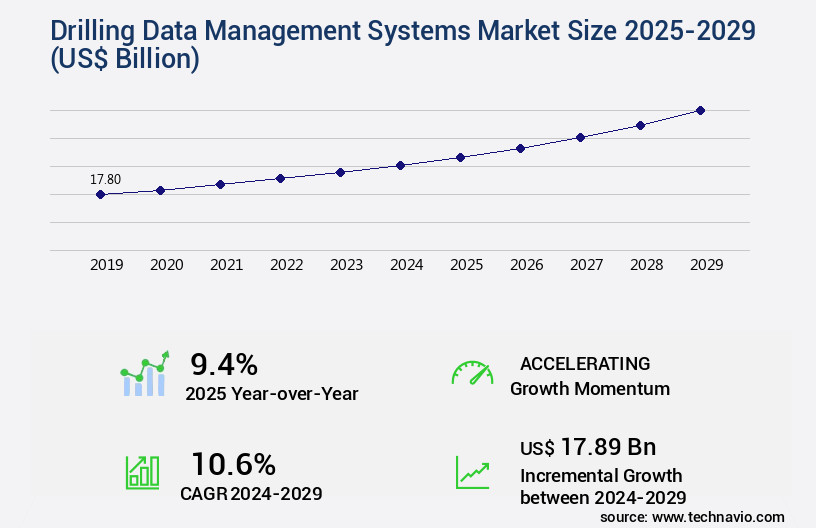
Get Key Insights on Market Forecast (PDF) Request Free Sample
How is the Drilling Data Management Systems Market Segmented ?
The drilling data management systems industry research report provides comprehensive data (region-wise segment analysis), with forecasts and estimates in "USD billion" for the period 2025-2029, as well as historical data from 2019-2023 for the following segments.
- Component
- Application
- Oil and gas
- Energy and power
- Type
- Geography
- North America
- Europe
- Middle East and Africa
- APAC
- South America
- Rest of World (ROW)
By Component Insights
The services segment is estimated to witness significant growth during the forecast period.
The market is experiencing dynamic growth, fueled by the escalating need for advanced data handling solutions across multiple industries. With the generation of massive data volumes, organizations demand efficient, adaptable, and scalable data management systems. The services sector within this market encompasses a spectrum of activities, including sensor installation, equipment maintenance, consultation, and data analytics, all integral to various drilling stages. The market's expansion is influenced by emerging technologies like vertical drilling and Enhanced Oil Recovery (EOR), which streamline drilling processes and optimize oil extraction. According to a recent study, the services segment is projected to account for over 50% of the market share by 2025.
Technological advancements in data integration software, geophysical data management, wellsite data transfer, software-defined networking, data analytics platforms, and data visualization tools are transforming drilling operations. Additionally, investments in data compression algorithms, mud logging data, predictive drilling models, wellbore surveying data, data security protocols, data error correction, petrophysical data analysis, remote data access, well trajectory tracking, automated reporting systems, cloud-based data storage, hydraulics optimization, data validation techniques, downhole sensor integration, data acquisition systems, edge computing technologies, directional drilling data, data quality control, real-time data processing, formation evaluation data, drilling parameters monitoring, drilling optimization algorithms, and data redundancy management are shaping the future of drilling data management systems.
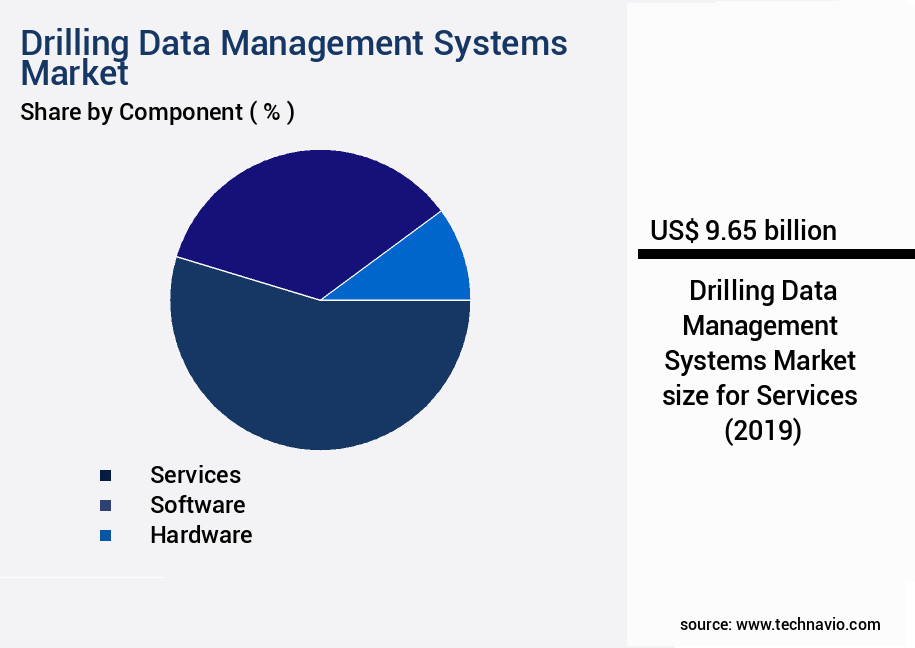
Request Free Sample
The Services segment was valued at USD 9.65 billion in 2019 and showed a gradual increase during the forecast period.
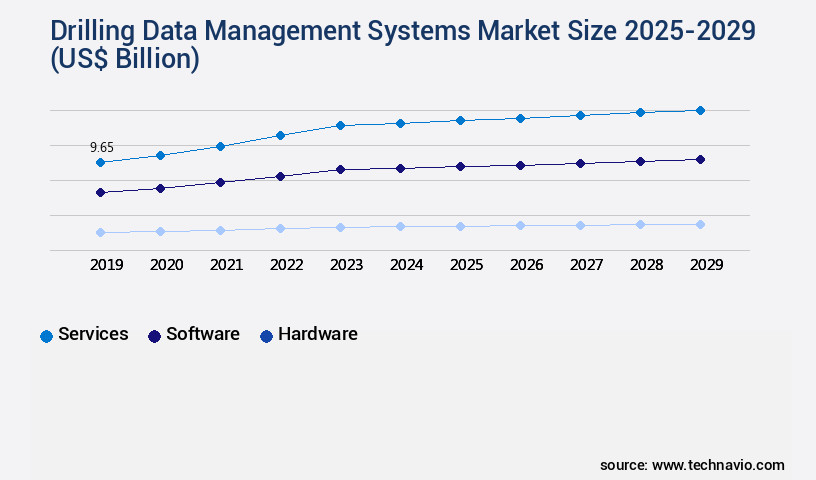
Request Free Sample
Regional Analysis
North America is estimated to contribute 42% to the growth of the global market during the forecast period.Technavio’s analysts have elaborately explained the regional trends and drivers that shape the market during the forecast period.
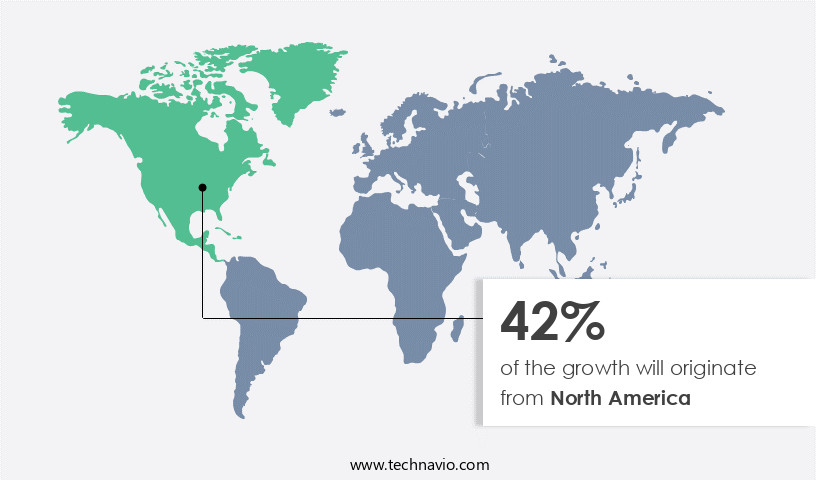
See How Drilling Data Management Systems Market Demand is Rising in North America Request Free Sample
The market in North America is primarily driven by the major revenue-contributing countries, the US and Canada. These countries are the top oil-producing nations in the region, with abundant oil resources. The shale revolution in the US has significantly impacted the oil production of the region, enabling oil companies to maintain profitability even with low oil prices. This revolution has had a substantial influence on the upstream oil and gas industry, leading to the commercialization of hydraulic fracturing technology and the entry of numerous small and independent energy players.
Consequently, drilling activities in the region have seen a considerable surge, propelling the growth of the market.
Market Dynamics
Our researchers analyzed the data with 2024 as the base year, along with the key drivers, trends, and challenges. A holistic analysis of drivers will help companies refine their marketing strategies to gain a competitive advantage.
The market is experiencing significant growth due to the increasing demand for automated data acquisition and real-time visualization of drilling parameters. These systems enable wellbore stability analysis, drilling optimization models, and reservoir characterization workflows by integrating data from various sources. Cloud-based storage solutions offer advantages such as data security, accessibility, and scalability, making them a popular choice for drilling companies.
Predictive maintenance and performance monitoring of drilling equipment are crucial aspects of these systems. Real-time data transmission from sensor networks and downhole calibration procedures ensure data accuracy and reliability. Data compression techniques and data redundancy management with fault tolerance enhance data transfer and improve decision-making in high-speed drilling operations.
Data security best practices implementation, including advanced data analytics and encryption, are essential to protect sensitive drilling information. Software-defined networking improves data connectivity, while data error correction techniques ensure accuracy and consistency. Automated reporting systems provide drilling performance metrics, enabling continuous optimization and improvement.
Remote data access with secure protocols and data lifecycle management strategies are vital for efficient drilling operations. Regulatory compliance is ensured through these systems, ensuring adherence to industry standards and regulations. Overall, drilling data management systems offer significant benefits in terms of operational efficiency, equipment performance, and data security, making them an indispensable tool for drilling companies.
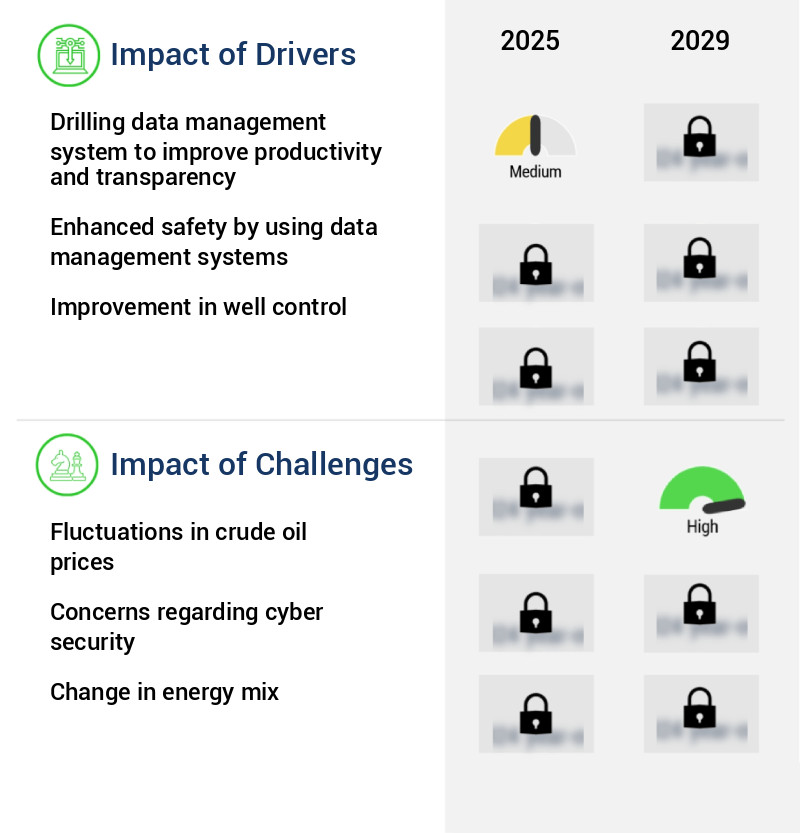
What are the key market drivers leading to the rise in the adoption of Drilling Data Management Systems Industry?
- The implementation of advanced drilling data management systems is a crucial factor in enhancing productivity and promoting transparency within the market, driving its growth.
- Drilling Data Management Systems (DDMS) have gained significant traction in the oil and gas industry due to their ability to enhance productivity and transparency in drilling operations. These systems enable companies to collect, manage, and analyze real-time data related to drilling processes. By utilizing DDMS, drilling firms can optimize their operations by identifying inefficiencies and reducing drilling time and costs. Additionally, DDMS offers transparency, granting stakeholders access to real-time information on drilling performance, parameters, and costs.
- The implementation of DDMS contributes to increased drilling efficiency and overall productivity in Exploration and Production (E and P) operations.
What are the market trends shaping the Drilling Data Management Systems Industry?
- The arrival of big data analytics is mandated as the upcoming market trend.
Big data analytics is set to be the mandatory market trend.
- The drilling data management system market is experiencing significant growth in response to the challenges faced by the oil and gas industry. Issues such as the depletion of oil wells, the need for information on new drilling locations, and the requirement to minimize pollution and comply with regulations are driving the adoption of advanced technologies in drilling data management. As a result, an enormous volume of data is generated, presenting opportunities for transformation. Oil companies can leverage big data analytics to gain real-time insights and analyze historical data and trends to make informed decisions and forecast future predictions. According to recent estimates, the drilling data management market is projected to expand at a substantial rate, with the number of applications extending beyond the oil and gas sector to include mining, construction, and utilities.
- Effective utilization of drilling data can lead to improved operational efficiency, reduced costs, and enhanced safety measures.
What challenges does the Drilling Data Management Systems Industry face during its growth?
- The volatility of crude oil prices poses a significant challenge to the growth of the industry.
- The oil and gas industry faces a complex terrain influenced by geopolitical factors, economic shifts, and technological advancements. In 2024, the industry is projected to maintain a robust financial position, bolstered by high oil prices that foster investments and dividends. The global upstream sector is estimated to preserve its 2023 hydrocarbon investment level of approximately USD580 billion, generating over USD800 billion in free cash flow. Pivotal trends shaping the industry include capital allocation efficiency, clean energy policies, escalating geopolitical tensions, and investments in low-carbon technology projects. Crude oil price fluctuations significantly impact the global drilling data management system market.
- This market plays a crucial role in facilitating data-driven decision-making for oil and gas companies, enabling them to optimize operations, reduce costs, and enhance overall performance. The system's applications extend beyond the oil and gas sector, with industries like mining, power, and water utilities also reaping benefits from advanced data management solutions.
Exclusive Technavio Analysis on Customer Landscape
The drilling data management systems market forecasting report includes the adoption lifecycle of the market, covering from the innovator’s stage to the laggard’s stage. It focuses on adoption rates in different regions based on penetration. Furthermore, the drilling data management systems market report also includes key purchase criteria and drivers of price sensitivity to help companies evaluate and develop their market growth analysis strategies.
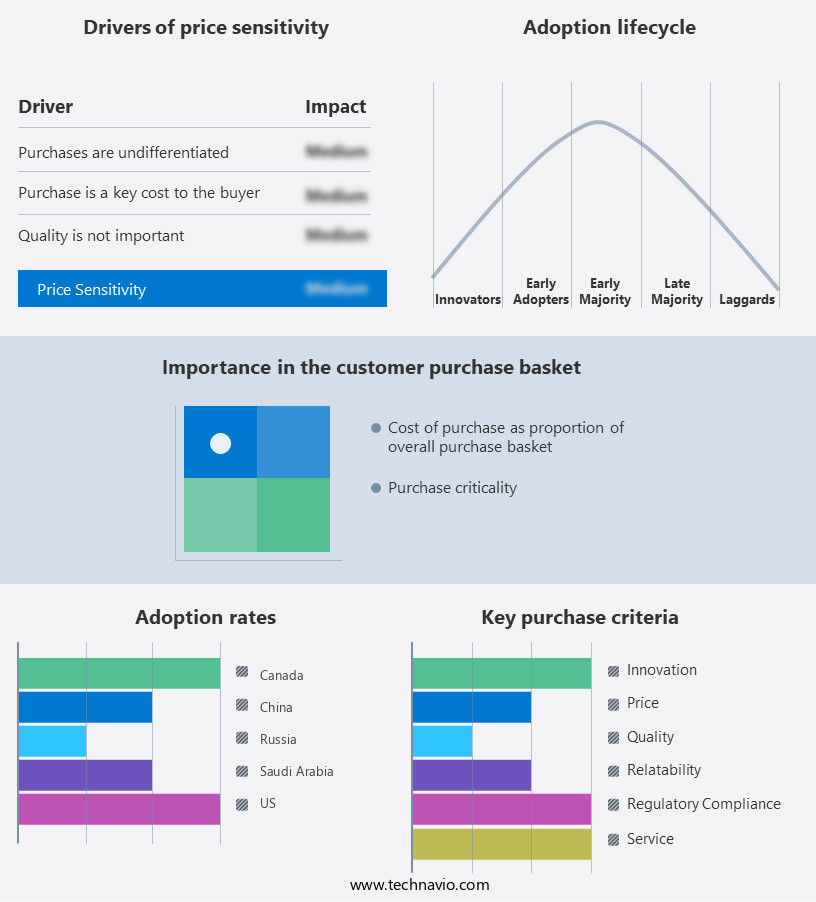
Customer Landscape of Drilling Data Management Systems Industry
Competitive Landscape
Companies are implementing various strategies, such as strategic alliances, drilling data management systems market forecast, partnerships, mergers and acquisitions, geographical expansion, and product/service launches, to enhance their presence in the industry.
Accenture PLC - Saipem, a global leader in oil and gas engineering and construction, utilizes the Company's Construction Data Management Solution. This innovative technology streamlines project management, enhancing efficiency and accuracy in the complex construction process. The solution's advanced features facilitate seamless data exchange, enabling real-time progress tracking and informed decision-making.
The industry research and growth report includes detailed analyses of the competitive landscape of the market and information about key companies, including:
- Accenture PLC
- Baker Hughes Co.
- Capgemini Services SAS
- Dell Technologies Inc.
- Halliburton Co.
- Honeywell International Inc.
- Infosys Ltd.
- International Business Machines Corp.
- NOV Inc.
- Oracle Corp.
- Pason Systems Inc.
- SAP SE
- SAS Institute Inc.
- Schlumberger Ltd.
- Tata Consultancy Services Ltd.
- Teradata Corp.
- Trackem
- Wipro Ltd.
Qualitative and quantitative analysis of companies has been conducted to help clients understand the wider business environment as well as the strengths and weaknesses of key industry players. Data is qualitatively analyzed to categorize companies as pure play, category-focused, industry-focused, and diversified; it is quantitatively analyzed to categorize companies as dominant, leading, strong, tentative, and weak.
Recent Development and News in Drilling Data Management Systems Market
- In January 2024, Schlumberger, a leading oilfield services company, launched its new Drilling Wise data management system, integrating artificial intelligence and machine learning capabilities to optimize drilling operations (Schlumberger press release). In March 2024, Halliburton and Baker Hughes, two major players in the drilling industry, announced a strategic collaboration to develop a joint drilling data management platform, aiming to enhance operational efficiency and reduce costs (Halliburton press release).
- In April 2025, Aker Solutions, a Norwegian engineering and technology company, acquired Drill-Quip's drilling systems business, strengthening its position in the drilling data management market and expanding its offering to include drilling equipment and services (Aker Solutions press release). In May 2025, the US Bureau of Safety and Environmental Enforcement (BSEE) introduced new regulations mandating the use of real-time drilling data reporting systems for offshore drilling operations, effective from 2026 (BSEE press release). These developments underscore the growing importance of advanced data management systems in the drilling industry, with significant investments in technology and strategic partnerships to meet evolving regulatory requirements.
Dive into Technavio’s robust research methodology, blending expert interviews, extensive data synthesis, and validated models for unparalleled Drilling Data Management Systems Market insights. See full methodology.
|
Market Scope
|
|
Report Coverage
|
Details
|
|
Page number
|
210
|
|
Base year
|
2024
|
|
Historic period
|
2019-2023 |
|
Forecast period
|
2025-2029
|
|
Growth momentum & CAGR
|
Accelerate at a CAGR of 10.6%
|
|
Market growth 2025-2029
|
USD 17.89 billion
|
|
Market structure
|
Fragmented
|
|
YoY growth 2024-2025(%)
|
9.4
|
|
Key countries
|
US, Canada, Norway, UK, Australia, Saudi Arabia, UAE, Mexico, Russia, and Brazil
|
|
Competitive landscape
|
Leading Companies, Market Positioning of Companies, Competitive Strategies, and Industry Risks
|
Request Free Sample
Research Analyst Overview
- The market continues to evolve, driven by the increasing complexity of geophysical data and the need for real-time analysis and optimization in various sectors. Data integration software plays a crucial role in managing the influx of wellsite data, ensuring seamless transfer through software-defined networking. Geophysical data management systems employ data analytics platforms and reservoir simulation data to enhance exploration and production efficiency. Downhole sensor integration, mud logging data, and wellbore surveying data are essential components of drilling operations. Predictive drilling models and drilling parameters monitoring enable proactive decision-making, while data visualization tools facilitate effective communication among team members.
- Data compression algorithms and data validation techniques ensure data accuracy and security. Remote data access and real-time data processing are critical for efficient drilling operations. Cloud-based data storage and automated reporting systems streamline data management, allowing for quicker response times and improved decision-making. Hydraulics optimization and directional drilling data contribute to increased drilling efficiency and reduced costs. Industry growth in drilling data management systems is expected to reach 15% annually, driven by the increasing adoption of advanced technologies such as edge computing and data redundancy management. For instance, a leading oil and gas company reported a 20% increase in drilling efficiency by implementing real-time data processing and predictive drilling models.
- Data quality control and automated reporting systems further enhance operational efficiency and ensure regulatory compliance.
What are the Key Data Covered in this Drilling Data Management Systems Market Research and Growth Report?
-
What is the expected growth of the Drilling Data Management Systems Market between 2025 and 2029?
-
What segmentation does the market report cover?
-
The report is segmented by Component (Services, Software, and Hardware), Application (Oil and gas and Energy and power), Geography (North America, Middle East and Africa, Europe, APAC, and South America), and Type (Onshore and Offshore)
-
Which regions are analyzed in the report?
-
North America, Middle East and Africa, Europe, APAC, and South America
-
What are the key growth drivers and market challenges?
-
Who are the major players in the Drilling Data Management Systems Market?
-
Accenture PLC, Baker Hughes Co., Capgemini Services SAS, Dell Technologies Inc., Halliburton Co., Honeywell International Inc., Infosys Ltd., International Business Machines Corp., NOV Inc., Oracle Corp., Pason Systems Inc., SAP SE, SAS Institute Inc., Schlumberger Ltd., Tata Consultancy Services Ltd., Teradata Corp., Trackem, and Wipro Ltd.
Market Research Insights
- The market for drilling data management systems is a continually evolving landscape, with ongoing advancements in technology driving innovation. Two key areas of focus include remote operations and production optimization. For instance, the integration of temperature sensors and real-time monitoring has led to significant improvements in drilling efficiency, resulting in a reported increase of up to 15% in well productivity. Furthermore, industry growth is anticipated to expand at a steady pace, with expectations of a 10% compound annual growth rate.
- These developments underscore the importance of robust data management systems, which enable the seamless organization and retrieval of critical drilling data, including pressure monitoring systems, sensor calibration methods, and mud flow monitoring data. Additionally, data lifecycle management, data version control, and data communication protocols are essential components of these systems, ensuring data consistency and accuracy throughout the drilling process.
We can help! Our analysts can customize this drilling data management systems market research report to meet your requirements.
Get in touch
1 Executive Summary
- 1.1 Market overview
- Executive Summary - Chart on Market Overview
- Executive Summary - Data Table on Market Overview
- Executive Summary - Chart on Global Market Characteristics
- Executive Summary - Chart on Market by Geography
- Executive Summary - Chart on Market Segmentation by Component
- Executive Summary - Chart on Market Segmentation by Application
- Executive Summary - Chart on Incremental Growth
- Executive Summary - Data Table on Incremental Growth
- Executive Summary - Chart on Company Market Positioning
2 Technavio Analysis
- 2.1 Analysis of price sensitivity, lifecycle, customer purchase basket, adoption rates, and purchase criteria
- Analysis of price sensitivity, lifecycle, customer purchase basket, adoption rates, and purchase criteria
- 2.2 Criticality of inputs and Factors of differentiation
- Overview on criticality of inputs and factors of differentiation
- 2.3 Factors of disruption
- Overview on factors of disruption
- 2.4 Impact of drivers and challenges
- Impact of drivers and challenges in 2024 and 2029
3 Market Landscape
- 3.1 Market ecosystem
- Parent Market
- Data Table on - Parent Market
- 3.2 Market characteristics
- Market characteristics analysis
4 Market Sizing
- 4.1 Market definition
- Offerings of companies included in the market definition
- 4.2 Market segment analysis
- 4.4 Market outlook: Forecast for 2024-2029
- Chart on Global - Market size and forecast 2024-2029 ($ million)
- Data Table on Global - Market size and forecast 2024-2029 ($ million)
- Chart on Global Market: Year-over-year growth 2024-2029 (%)
- Data Table on Global Market: Year-over-year growth 2024-2029 (%)
5 Historic Market Size
- 5.1 Global Drilling Data Management Systems Market 2019 - 2023
- Historic Market Size - Data Table on Global Drilling Data Management Systems Market 2019 - 2023 ($ million)
- 5.2 Component segment analysis 2019 - 2023
- Historic Market Size - Component Segment 2019 - 2023 ($ million)
- 5.3 Application segment analysis 2019 - 2023
- Historic Market Size - Application Segment 2019 - 2023 ($ million)
- 5.4 Geography segment analysis 2019 - 2023
- Historic Market Size - Geography Segment 2019 - 2023 ($ million)
- 5.5 Country segment analysis 2019 - 2023
- Historic Market Size - Country Segment 2019 - 2023 ($ million)
6 Qualitative Analysis
- 6.1 The AI impact on global drilling data management systems market
7 Five Forces Analysis
- 7.1 Five forces summary
- Five forces analysis - Comparison between 2024 and 2029
- 7.2 Bargaining power of buyers
- Bargaining power of buyers - Impact of key factors 2024 and 2029
- 7.3 Bargaining power of suppliers
- Bargaining power of suppliers - Impact of key factors in 2024 and 2029
- 7.4 Threat of new entrants
- Threat of new entrants - Impact of key factors in 2024 and 2029
- 7.5 Threat of substitutes
- Threat of substitutes - Impact of key factors in 2024 and 2029
- 7.6 Threat of rivalry
- Threat of rivalry - Impact of key factors in 2024 and 2029
- 7.7 Market condition
- Chart on Market condition - Five forces 2024 and 2029
8 Market Segmentation by Component
- 8.1 Market segments
- Chart on Component - Market share (2024-2029) (%)
- Data Table on Component - Market share (2024-2029) (%)
- 8.2 Comparison by Component
- Chart on Comparison by Component
- Data Table on Comparison by Component
- 8.3 Services - Market size and forecast (2024-2029)
- Chart on Services - Market size and forecast (2024-2029) ($ million)
- Data Table on Services - Market size and forecast (2024-2029) ($ million)
- Chart on Services - Year-over-year growth (2024-2029) (%)
- Data Table on Services - Year-over-year growth (2024-2029) (%)
- 8.4 Software - Market size and forecast (2024-2029)
- Chart on Software - Market size and forecast (2024-2029) ($ million)
- Data Table on Software - Market size and forecast (2024-2029) ($ million)
- Chart on Software - Year-over-year growth (2024-2029) (%)
- Data Table on Software - Year-over-year growth (2024-2029) (%)
- 8.5 Hardware - Market size and forecast (2024-2029)
- Chart on Hardware - Market size and forecast (2024-2029) ($ million)
- Data Table on Hardware - Market size and forecast (2024-2029) ($ million)
- Chart on Hardware - Year-over-year growth (2024-2029) (%)
- Data Table on Hardware - Year-over-year growth (2024-2029) (%)
- 8.6 Market opportunity by Component
- Market opportunity by Component ($ million)
- Data Table on Market opportunity by Component ($ million)
9 Market Segmentation by Application
- 9.1 Market segments
- Chart on Application - Market share (2024-2029) (%)
- Data Table on Application - Market share (2024-2029) (%)
- 9.2 Comparison by Application
- Chart on Comparison by Application
- Data Table on Comparison by Application
- 9.3 Oil and gas - Market size and forecast (2024-2029)
- Chart on Oil and gas - Market size and forecast (2024-2029) ($ million)
- Data Table on Oil and gas - Market size and forecast (2024-2029) ($ million)
- Chart on Oil and gas - Year-over-year growth (2024-2029) (%)
- Data Table on Oil and gas - Year-over-year growth (2024-2029) (%)
- 9.4 Energy and power - Market size and forecast (2024-2029)
- Chart on Energy and power - Market size and forecast (2024-2029) ($ million)
- Data Table on Energy and power - Market size and forecast (2024-2029) ($ million)
- Chart on Energy and power - Year-over-year growth (2024-2029) (%)
- Data Table on Energy and power - Year-over-year growth (2024-2029) (%)
- 9.5 Market opportunity by Application
- Market opportunity by Application ($ million)
- Data Table on Market opportunity by Application ($ million)
10 Market Segmentation by Type
- 10.1 Market segments
- Chart on Type - Market share (2024-2029) (%)
- Data Table on Type - Market share (2024-2029) (%)
- 10.2 Comparison by Type
- Chart on Comparison by Type
- Data Table on Comparison by Type
- 10.3 Onshore - Market size and forecast (2024-2029)
- Chart on Onshore - Market size and forecast (2024-2029) ($ million)
- Data Table on Onshore - Market size and forecast (2024-2029) ($ million)
- Chart on Onshore - Year-over-year growth (2024-2029) (%)
- Data Table on Onshore - Year-over-year growth (2024-2029) (%)
- 10.4 Offshore - Market size and forecast (2024-2029)
- Chart on Offshore - Market size and forecast (2024-2029) ($ million)
- Data Table on Offshore - Market size and forecast (2024-2029) ($ million)
- Chart on Offshore - Year-over-year growth (2024-2029) (%)
- Data Table on Offshore - Year-over-year growth (2024-2029) (%)
- 10.5 Market opportunity by Type
- Market opportunity by Type ($ million)
- Data Table on Market opportunity by Type ($ million)
11 Customer Landscape
- 11.1 Customer landscape overview
- Analysis of price sensitivity, lifecycle, customer purchase basket, adoption rates, and purchase criteria
12 Geographic Landscape
- 12.1 Geographic segmentation
- Chart on Market share by geography 2024-2029 (%)
- Data Table on Market share by geography 2024-2029 (%)
- 12.2 Geographic comparison
- Chart on Geographic comparison
- Data Table on Geographic comparison
- 12.3 North America - Market size and forecast 2024-2029
- Chart on North America - Market size and forecast 2024-2029 ($ million)
- Data Table on North America - Market size and forecast 2024-2029 ($ million)
- Chart on North America - Year-over-year growth 2024-2029 (%)
- Data Table on North America - Year-over-year growth 2024-2029 (%)
- 12.4 Middle East and Africa - Market size and forecast 2024-2029
- Chart on Middle East and Africa - Market size and forecast 2024-2029 ($ million)
- Data Table on Middle East and Africa - Market size and forecast 2024-2029 ($ million)
- Chart on Middle East and Africa - Year-over-year growth 2024-2029 (%)
- Data Table on Middle East and Africa - Year-over-year growth 2024-2029 (%)
- 12.5 Europe - Market size and forecast 2024-2029
- Chart on Europe - Market size and forecast 2024-2029 ($ million)
- Data Table on Europe - Market size and forecast 2024-2029 ($ million)
- Chart on Europe - Year-over-year growth 2024-2029 (%)
- Data Table on Europe - Year-over-year growth 2024-2029 (%)
- 12.6 APAC - Market size and forecast 2024-2029
- Chart on APAC - Market size and forecast 2024-2029 ($ million)
- Data Table on APAC - Market size and forecast 2024-2029 ($ million)
- Chart on APAC - Year-over-year growth 2024-2029 (%)
- Data Table on APAC - Year-over-year growth 2024-2029 (%)
- 12.7 South America - Market size and forecast 2024-2029
- Chart on South America - Market size and forecast 2024-2029 ($ million)
- Data Table on South America - Market size and forecast 2024-2029 ($ million)
- Chart on South America - Year-over-year growth 2024-2029 (%)
- Data Table on South America - Year-over-year growth 2024-2029 (%)
- 12.8 US - Market size and forecast 2024-2029
- Chart on US - Market size and forecast 2024-2029 ($ million)
- Data Table on US - Market size and forecast 2024-2029 ($ million)
- Chart on US - Year-over-year growth 2024-2029 (%)
- Data Table on US - Year-over-year growth 2024-2029 (%)
- 12.9 Canada - Market size and forecast 2024-2029
- Chart on Canada - Market size and forecast 2024-2029 ($ million)
- Data Table on Canada - Market size and forecast 2024-2029 ($ million)
- Chart on Canada - Year-over-year growth 2024-2029 (%)
- Data Table on Canada - Year-over-year growth 2024-2029 (%)
- 12.10 Norway - Market size and forecast 2024-2029
- Chart on Norway - Market size and forecast 2024-2029 ($ million)
- Data Table on Norway - Market size and forecast 2024-2029 ($ million)
- Chart on Norway - Year-over-year growth 2024-2029 (%)
- Data Table on Norway - Year-over-year growth 2024-2029 (%)
- 12.11 UK - Market size and forecast 2024-2029
- Chart on UK - Market size and forecast 2024-2029 ($ million)
- Data Table on UK - Market size and forecast 2024-2029 ($ million)
- Chart on UK - Year-over-year growth 2024-2029 (%)
- Data Table on UK - Year-over-year growth 2024-2029 (%)
- 12.12 Australia - Market size and forecast 2024-2029
- Chart on Australia - Market size and forecast 2024-2029 ($ million)
- Data Table on Australia - Market size and forecast 2024-2029 ($ million)
- Chart on Australia - Year-over-year growth 2024-2029 (%)
- Data Table on Australia - Year-over-year growth 2024-2029 (%)
- 12.13 Saudi Arabia - Market size and forecast 2024-2029
- Chart on Saudi Arabia - Market size and forecast 2024-2029 ($ million)
- Data Table on Saudi Arabia - Market size and forecast 2024-2029 ($ million)
- Chart on Saudi Arabia - Year-over-year growth 2024-2029 (%)
- Data Table on Saudi Arabia - Year-over-year growth 2024-2029 (%)
- 12.14 UAE - Market size and forecast 2024-2029
- Chart on UAE - Market size and forecast 2024-2029 ($ million)
- Data Table on UAE - Market size and forecast 2024-2029 ($ million)
- Chart on UAE - Year-over-year growth 2024-2029 (%)
- Data Table on UAE - Year-over-year growth 2024-2029 (%)
- 12.15 Mexico - Market size and forecast 2024-2029
- Chart on Mexico - Market size and forecast 2024-2029 ($ million)
- Data Table on Mexico - Market size and forecast 2024-2029 ($ million)
- Chart on Mexico - Year-over-year growth 2024-2029 (%)
- Data Table on Mexico - Year-over-year growth 2024-2029 (%)
- 12.16 Russia - Market size and forecast 2024-2029
- Chart on Russia - Market size and forecast 2024-2029 ($ million)
- Data Table on Russia - Market size and forecast 2024-2029 ($ million)
- Chart on Russia - Year-over-year growth 2024-2029 (%)
- Data Table on Russia - Year-over-year growth 2024-2029 (%)
- 12.17 Brazil - Market size and forecast 2024-2029
- Chart on Brazil - Market size and forecast 2024-2029 ($ million)
- Data Table on Brazil - Market size and forecast 2024-2029 ($ million)
- Chart on Brazil - Year-over-year growth 2024-2029 (%)
- Data Table on Brazil - Year-over-year growth 2024-2029 (%)
- 12.18 Market opportunity by geography
- Market opportunity by geography ($ million)
- Data Tables on Market opportunity by geography ($ million)
- 12.19 Rest of World (ROW) - Market size and forecast (2024-2029)
- Chart on Rest of World (ROW) - Market size and forecast (2024-2029) ($ million)
- Data Table on Rest of World (ROW) - Market size and forecast (2024-2029) ($ million)
- Chart on Rest of World (ROW) - Year-over-year growth (2024-2029) (%)
- Data Table on Rest of World (ROW) - Year-over-year growth (2024-2029) (%)
13 Drivers, Challenges, and Opportunity/Restraints
- 13.3 Impact of drivers and challenges
- Impact of drivers and challenges in 2024 and 2029
- 13.4 Market opportunities/restraints
14 Competitive Landscape
- 14.2 Competitive Landscape
- Overview on criticality of inputs and factors of differentiation
- 14.3 Landscape disruption
- Overview on factors of disruption
- 14.4 Industry risks
- Impact of key risks on business
15 Competitive Analysis
- 15.2 Company ranking index
- 15.3 Market positioning of companies
- Matrix on companies position and classification
- 15.4 Accenture PLC
- Accenture PLC - Overview
- Accenture PLC - Business segments
- Accenture PLC - Key news
- Accenture PLC - Key offerings
- Accenture PLC - Segment focus
- SWOT
- 15.5 Baker Hughes Co.
- Baker Hughes Co. - Overview
- Baker Hughes Co. - Business segments
- Baker Hughes Co. - Key news
- Baker Hughes Co. - Key offerings
- Baker Hughes Co. - Segment focus
- SWOT
- 15.6 Capgemini Services SAS
- Capgemini Services SAS - Overview
- Capgemini Services SAS - Business segments
- Capgemini Services SAS - Key news
- Capgemini Services SAS - Key offerings
- Capgemini Services SAS - Segment focus
- SWOT
- 15.7 Dell Technologies Inc.
- Dell Technologies Inc. - Overview
- Dell Technologies Inc. - Business segments
- Dell Technologies Inc. - Key news
- Dell Technologies Inc. - Key offerings
- Dell Technologies Inc. - Segment focus
- SWOT
- 15.8 Halliburton Co.
- Halliburton Co. - Overview
- Halliburton Co. - Business segments
- Halliburton Co. - Key news
- Halliburton Co. - Key offerings
- Halliburton Co. - Segment focus
- SWOT
- 15.9 Honeywell International Inc.
- Honeywell International Inc. - Overview
- Honeywell International Inc. - Business segments
- Honeywell International Inc. - Key news
- Honeywell International Inc. - Key offerings
- Honeywell International Inc. - Segment focus
- SWOT
- 15.10 Infosys Ltd.
- Infosys Ltd. - Overview
- Infosys Ltd. - Business segments
- Infosys Ltd. - Key news
- Infosys Ltd. - Key offerings
- Infosys Ltd. - Segment focus
- SWOT
- 15.11 International Business Machines Corp.
- International Business Machines Corp. - Overview
- International Business Machines Corp. - Business segments
- International Business Machines Corp. - Key news
- International Business Machines Corp. - Key offerings
- International Business Machines Corp. - Segment focus
- SWOT
- 15.12 NOV Inc.
- NOV Inc. - Overview
- NOV Inc. - Business segments
- NOV Inc. - Key news
- NOV Inc. - Key offerings
- NOV Inc. - Segment focus
- SWOT
- 15.13 Oracle Corp.
- Oracle Corp. - Overview
- Oracle Corp. - Business segments
- Oracle Corp. - Key news
- Oracle Corp. - Key offerings
- Oracle Corp. - Segment focus
- SWOT
- 15.14 Pason Systems Inc.
- Pason Systems Inc. - Overview
- Pason Systems Inc. - Product / Service
- Pason Systems Inc. - Key offerings
- SWOT
- 15.15 SAP SE
- SAP SE - Overview
- SAP SE - Business segments
- SAP SE - Key news
- SAP SE - Key offerings
- SAP SE - Segment focus
- SWOT
- 15.16 SAS Institute Inc.
- SAS Institute Inc. - Overview
- SAS Institute Inc. - Product / Service
- SAS Institute Inc. - Key news
- SAS Institute Inc. - Key offerings
- SWOT
- 15.17 Schlumberger Ltd.
- Schlumberger Ltd. - Overview
- Schlumberger Ltd. - Business segments
- Schlumberger Ltd. - Key news
- Schlumberger Ltd. - Key offerings
- Schlumberger Ltd. - Segment focus
- SWOT
- 15.18 Wipro Ltd.
- Wipro Ltd. - Overview
- Wipro Ltd. - Business segments
- Wipro Ltd. - Key news
- Wipro Ltd. - Key offerings
- Wipro Ltd. - Segment focus
- SWOT
16 Appendix
- 16.2 Inclusions and exclusions checklist
- Inclusions checklist
- Exclusions checklist
- 16.3 Currency conversion rates for US$
- Currency conversion rates for US$
- 16.4 Research methodology
- 16.7 Validation techniques employed for market sizing
- Validation techniques employed for market sizing
- 16.9 360 degree market analysis
- 360 degree market analysis
- 16.10 List of abbreviations







![]() Get the report (PDF) sent to your email within minutes.
Get the report (PDF) sent to your email within minutes.
Complimentary full Excel data with your report purchase.